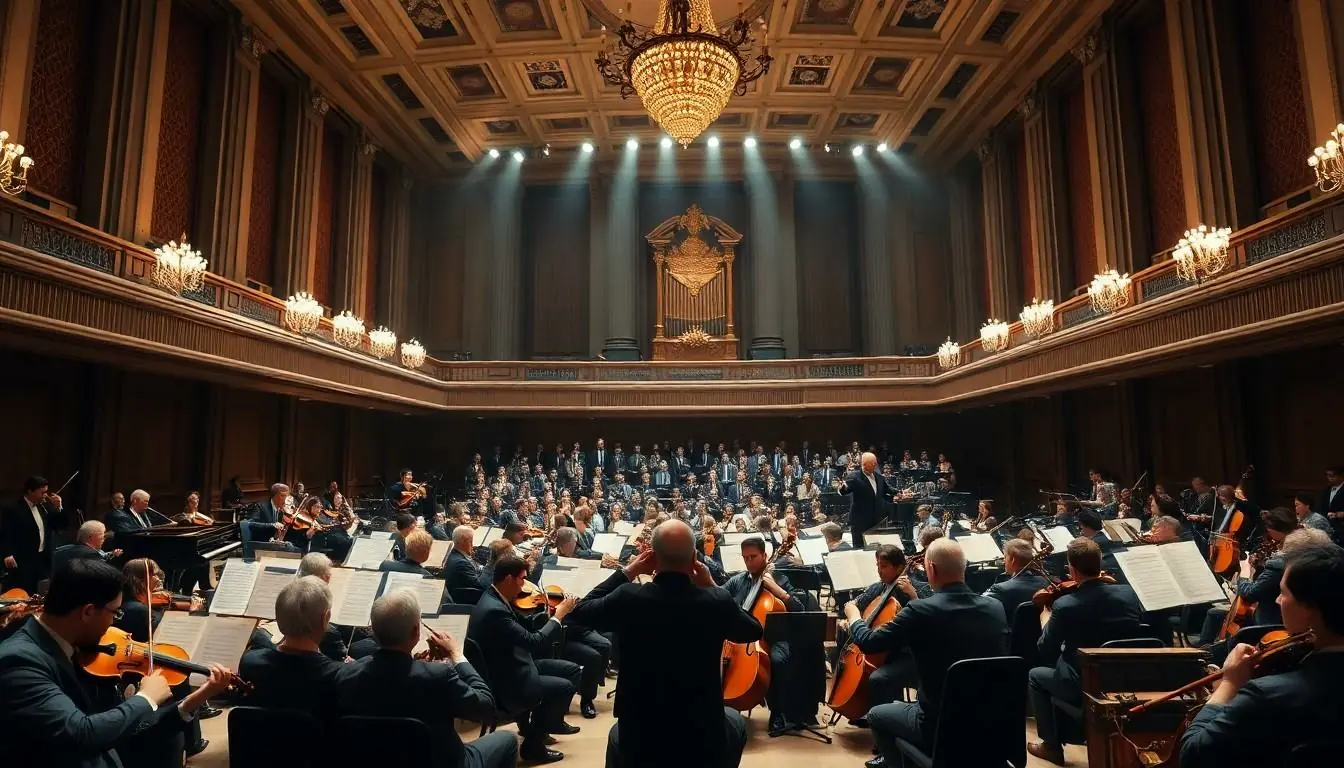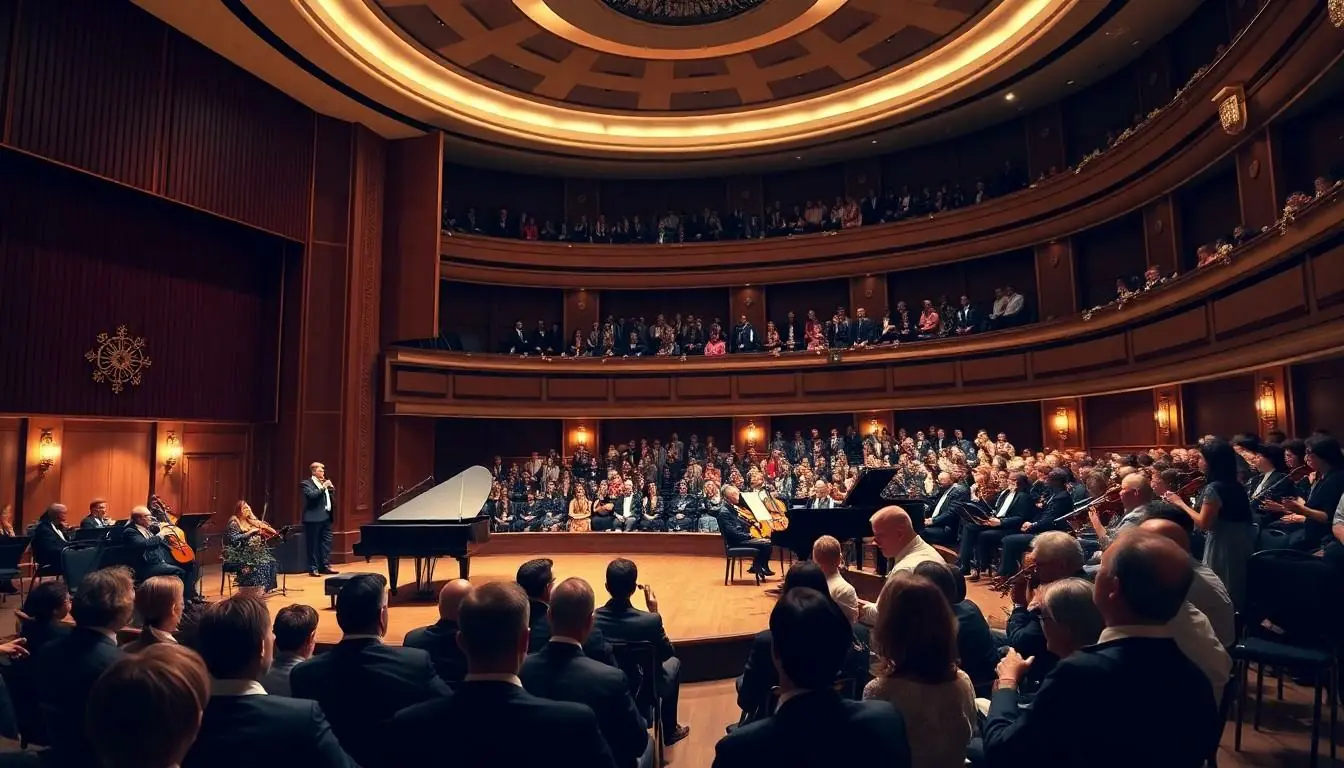Music has a magical way of stirring emotions, and when it comes to romantic and classical genres, the debate can get as heated as a passionate love affair. Romantic music, with its sweeping melodies and heartfelt lyrics, pulls at the heartstrings like a skilled violinist. On the other hand, classical music stands tall, exuding sophistication and timeless elegance—perfect for impressing that special someone or simply feeling like a genius.
Table of Contents
ToggleOverview of Romantic and Classical Music
Romantic music emerged in the late 18th century and flourished throughout the 19th century. This genre emphasizes emotional expression, featuring sweeping melodies and intricate harmonies. Composers like Chopin and Liszt excelled in conveying passion through their works. Listeners often experience heightened feelings of love, nostalgia, and longing when engaged with romantic music.
In contrast, classical music encompasses a broader historical range, from the Baroque era to the early Romantic period. Composers such as Mozart and Beethoven played significant roles in defining this style. Classical music prioritizes structure and form with clear melodies and symphonic orchestration. Many people appreciate its elegance and the intellectual engagement it provides, often finding it suitable for formal occasions.
Romantic music showcases individualism and creativity, breaking traditional boundaries set by classical music. Its thematic focus on nature, love, and the human experience offers a vivid contrast to the disciplined approach of classical compositions. Both genres encompass unique elements that appeal to varied auditory preferences.
Emotional depth often characterizes romantic music, inviting listeners to connect on a personal level. Classical music, on the other hand, emphasizes technical skill and artistry, guiding listeners through intricate musical landscapes. Each genre offers a distinct yet complementary listening experience.
Understanding the two styles highlights their differences and similarities. Romantic music thrives on emotional response, while classical music represents sophistication and mastery. Both remain integral in music history, influencing contemporary composers and musicians alike.
Key Characteristics of Classical Music

Classical music showcases a refined elegance and complex structure that set it apart from other genres. This genre is known for its adherence to formal conventions, balancing intricate melodies with harmony and rhythm.
Structure and Form
Classical music relies on well-defined structures and forms. Compositions often follow recognizable patterns, such as sonatas, symphonies, and concertos. Each form serves a distinct purpose, guiding listeners through varying themes and motifs. A sonata typically features multiple movements, showcasing contrast and development. Symphonies expand these ideas into larger works, providing a rich tapestry of sound. The clarity in structure allows for intricate development and exploration of musical ideas.
Prominent Composers
Numerous composers have shaped classical music throughout history. Figures like Johann Sebastian Bach, Wolfgang Amadeus Mozart, and Ludwig van Beethoven stand out for their innovative approaches. Bach’s mastery of counterpoint set the foundation for future composers. Mozart revolutionized melody and harmony, bringing an emotional depth rarely seen before. Beethoven further pushed boundaries, integrating personal expression into classical forms. Each contributed unique elements, ensuring their works remain influential and revered today.
Key Characteristics of Romantic Music
Romantic music stands out due to its focus on deep emotional expression and individual creativity. This genre captures the essence of human emotion through its rich melodies and diverse emotional landscapes.
Emotional Expression
Emotional expression marks the heart of romantic music. Composers convey intense feelings of love, passion, and yearning, creating a personal connection for listeners. Sweeping melodies often evoke nostalgia, inviting reflections on past experiences. The harmonic complexity and use of dynamics enhance this connection, allowing individuals to resonate with the music personally. Instruments, particularly piano and strings, highlight emotional nuances, facilitating a powerful auditory experience. This genre transcends mere notes, immersing listeners in a profound realm of feeling and sentiment.
Influential Composers
Influential composers have shaped the romantic music landscape significantly. Frédéric Chopin illustrates the emotional depth through his piano works, frequently invoking feelings of longing and melancholy. Franz Liszt, known for his virtuosic style, enhances expressive performance with dramatic flair. Johannes Brahms combines classic structures with rich emotional content, appealing to both intellect and heart. Pyotr Ilyich Tchaikovsky masterfully integrates orchestration to convey complex emotions, enhancing narrative storytelling in his compositions. These composers, through their artistry, established romantic music as a cornerstone of emotional expression in the broader musical narrative.
Comparisons Between Romantic and Classical Music
Romantic and classical music exhibit distinct differences and similarities that appeal to listeners. Each genre employs unique musical techniques and thematic elements.
Musical Techniques
Romantic music showcases emotional expression through intricate harmonies and expanded forms. Composers like Chopin often utilized rich textures to draw listeners into deep emotional experiences. Classical music, in contrast, relies on precise structure and techniques. It favors forms such as sonatas and symphonies that expertly balance melody, harmony, and rhythm. Composers including Mozart applied clear lines and counterpoint, ensuring clarity. Furthermore, romantic composers incorporated abrupt dynamic shifts to amplify sentiment, while classical composers maintained consistent stylistic rules to convey ideas. These techniques underscore the distinct attributes of each genre, demonstrating their unique approaches to musical composition.
Thematic Elements
Romantic music thrives on themes of love, nature, and individual experience. Composers like Tchaikovsky vividly expressed personal struggles and passions through their works. Listeners often connect emotionally with this exploration of inner feelings. Classical music, on the other hand, emphasizes universal themes and structured forms. Its composers such as Beethoven conveyed ideas through organized variations and thematic development. Attention to form remains paramount in classical compositions, guiding listeners through clearly defined musical phrases. Both genres offer engaging explorations of human experience but approach thematic representation in significantly different ways.
The exploration of romantic and classical music reveals two distinct yet complementary expressions of human emotion and artistry. Romantic music captivates with its passionate melodies and personal connections, inviting listeners into a world of deep feelings and individual experiences. In contrast, classical music stands as a testament to structure and sophistication, showcasing the technical mastery of its composers.
Both genres enrich the musical landscape, offering unique insights into the human condition. Whether one seeks the emotional depth of romantic compositions or the refined elegance of classical pieces, each style holds its own significance. Together, they continue to inspire and influence musicians and listeners alike, ensuring their lasting legacy in the world of music.



